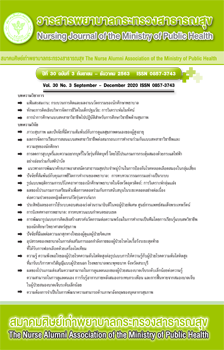Portfolio: Thinking Process and Innovation of Nursing Students
Main Article Content
Abstract
Portfolios have been used as a tool for developing several types of ideas including the process of thinking and doing (active learning). This article aims to explain the learning outcomes of an independent study course in which the nursing students were assigned to work in a small group on a STEM project. They reflected their learning outcomes by thinking and innovation products. Learning outcomes revealed three parts. Part 1, the Academic part, found that for the 10 components of 21st century skills (3Rs x 7Cs), students achieved a very good level in cooperation team work and leadership skills; good skills in reading, writing, and using math, computer information technology, creativity and innovation; and moderate skills in understanding cultural differences, communication skills and media literacy, career skills and learning skills. Learning outcomes according to the course’s criteria showed 9 groups of students achieved all 5 areas. Additionally, observations from their advisors also confirmed these skills, especially the skills in interpersonal relationships and responsibility. Part 2, regarding to the ability and progress, the students expressed that they have developed their learning skills, responsibility for group work, and information management skills. They appreciated their own efforts and took pride in the fact that their innovative work was of benefit to the patients. Part 3, Creativity skill, found that students created 9 innovative products from STEM projects by integrating four sciences, namely, Nursing and Health (S: Sciences), Technology (T: Technology), Engineering (E: Engineering) and Numerical Value (M: Mathematics). All products can be applied in nursing in the dimensions of health promotion, prevention, rehabilitation of clients. This study recommends the development of faculty skills with portfolios as well as the trial of portfolios for extensive learning in nursing education.
Article Details
บทความและรายงานวิจัยในวารสารพยาบาลกระทรวงสาธารณสุข เป็นความคิดเห็นของ ผู้เขียน มิใช่ของคณะผู้จัดทำ และมิใช่ความรับผิดชอบของสมาคมศิษย์เก่าพยาบาลกระทรวงสาธารณสุข ซึ่งสามารถนำไปอ้างอิงได้
References
2. Great Schools Partnership. Portfolio [internet]. 2016 [cited 2020 Mar 23]. Available from: https://
www.edglossary.org/portfolio/ .
3. Ministry of Education. Authentic Learning. [internet]. 2009 [cited 2020 Mar 23]. Available from: http://
www.thaischool.in.th/_files_school/40102105/document/40102105_0_20120707-120632.pdf.
4. Forker EJ, McDonald EM. Perspective on assessment methodology trends in the healthcare profession:
portfolio assessment. Nurse Educator 1996;21(5):9-10.
5. Barrett H. Create your own electronic portfolio. Learning & Leading with Technology 2000;27(7):14-21.
6. Hounsell D. Towards more sustainable feedback to students. In Boud D, Falchikov N, editors. Rethinking
assessment in higher education learning for the longer term. London: Routledge; 2007.
7. Garcia-Sanpedro MJ. Feedback and feedforward: focal points for improving academic performance. Journal
of Technology and Science Education 2012;2(2):77-85.
8. Wil M, Brussel PV, Linda VL. Portfolio in higher education: time for a clarificatory framework. International
Journal of Teaching and Learning in Higher Education 2006;17(2):127-35.
9. Jasper MA. Developing workbook for use in preregistration education–an action research approach. In Rolfe G,
editor.. Closing the theory practice gap–a new paradigm for nursing. Butterworth Heinemann: Oxford;1995.
10. Trilling R, Fadel C. 21st Century Skill: learning for life in our times. San Francisco: Jossey-Bass;2009.
11. Mohsen M, Seyyed MK, Jamileh MN, Morteza K. The portfolio as a tool for mentoring in nursing students: a scoping review. Iranian Journal of Nursing and Midwifery Research [internet].2018[cited 2020 Mar 23]. Available from: https://www.ncbi.nlm.nih.gov/pmc/articles/PMC6034526/.
12. Turner K, Leungratanamart L, Niranrat S, Jarnarerux J, Wattanakull B, Reunreang T. Twenty first century skills of nursing students of Boromarajonani College of Nursing, Chonburi. Nursing Journal of the Ministryof Public Health 2015;25(2):178-93.[in Thai].
13. Boromarajonani College of Nursing Chon Buri. Course syllabus independent study. Chon Buri: Boromarajonani College of Nursing;2016. [in Thai].
14. Busayano K. Brain-targeted teaching model: brain development and learning. Journal of Liberal Arts, Ubon Ratchathani 2016;12(2):159-76. [in Thai].
15. Siricharoen N. The model of communication for media and information literacy from the internet of Thai youths. Sripatum Review: Humanities and Social Sciences 2015;15(1):46-57. [in Thai].
16. Nursing Division Ministry of Public Health. Nursing Now Campaign [internet]. 2018 [cited 2020 Mar 23]. Available from: http://www.nursing.go.th/?p=7047.2518.
17. Siripatharachai P. STEM education and 21st century skills development. Executive Journal 2013;33(2):49-56. [in Thai].

